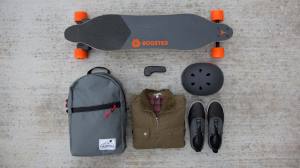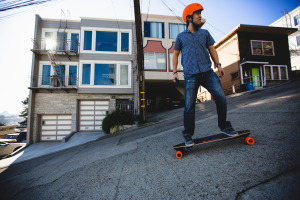Boosted Boards, a Stanford startup that raised over $460,000 in a Kickstarter campaign in late 2012, began officially selling its longboards in June this year. The Dish Daily was lucky enough to be able to ride one for a week to check it out.

The board was priced at $2,000, but as of today, Boosted Boards is offering a line of three products: Single, Dual and Dual+ models with boards starting at $999 for the Single, $1,299 for the Dual and $1,499 for the Dual+ (the original model), all significantly cheaper than the original board’s price tag of $2,000. Furthermore, for those who bit the bullet and bought the pricey boards early on, Boosted Board is showing its thanks with a price adjustment (up to $500 back). They have some more sweet perks that you can find on their website, including free upgrades as well as an extended warranty for current owners.
I should preface my comments with the disclaimer that I am an intermediate-to-experienced longboarder, having used one as my main mode of transportation over my freshman and sophomore years on the Farm. Occasionally, I sought out some hills in the area for recreation (the hill from the Knoll to Theta Delt, looping back down to Mayfield, for example, is a monster) so I’m fairly comfortable with speed. For the most part, I’ve used my longboard to commute to classes, so that’s the angle from which I’ll be reviewing the Boosted Board.
THE BOARD
The board is made with Loaded’s bamboo deck and Orangatang wheels in Caliber trucks. It has a 6-mile range, gets up to 20 miles per hour (the new Dual+ gets up to 25 mph, check out more of the updated specs below), and can climb up to a 15 percent grade. With the 40V lithium-ion phosphate battery, the board comes in at just 15 pounds, impressive for its power. The batteries, located around the housing, keep the board’s center of gravity very low, making for a smooth ride.
HOW TO

You begin by switching on the remote and turning on the motor on the underside of the board. There is an arrow on one tail of the board showing which way the acceleration goes. The remote itself has a gun-like trigger button (which activates the motor) and a dial that you push forward or backward to control acceleration. You tap the power button of the remote three times to switch from beginner to expert mode (and vice versa to get back to beginner), which allows you to go at a much faster speed and powerfully climb hills.
BRAKING
Once you become comfortable with the notion of applying acceleration in the opposite direction to slow down, then braking actually becomes a supremely gratifying activity when boarding. The Boosted Board has regenerative braking, which seemed cool at first but actually became somewhat intrusive when it came to riding at higher speeds.
One problem that I assume is because of the regenerative braking is that when you let go of the acceleration, you feel a slight jolt backwards (whereas I imagine that without the braking, you would continue riding at the same pace, slowing down at a more gradual rate). As such, you have to keep your thumb dialed all the way forward in order to continue riding at the same pace. Eventually, if you make the mile-long commute from Tresidder to Gates, then your hand starts cramping when you speed along Serra Mall, the straight stretch in front of Memorial Church.
BEGINNER AND EXPERT MODE
Beginner mode was a leisurely riding pace for an experienced longboarder, although often a little too slow for someone accustomed to speeding down hills through Stanford’s circle of death at a healthy speed. In general, I can see the board’s beginner mode as a viable way to get people started on longboarding. People quickly acclimate to the beginner mode speed and become comfortable leaning to turn right or left.
Perhaps my biggest complaint (and in my opinion, the lowest-hanging fruit to improve the boards) is the sheer difference in speed and sensitivity between the beginner and expert modes. On expert mode, the speed feels uncomfortably fast on flat ground, even to the most experienced longboarder. Although it becomes a lot more useful when climbing up hills, you have to exert a crazy amount of control on the hyper-sensitive dial.

Anyone who casually longboards and has a healthy risk aversion would probably be hesitant to use expert mode regularly, because an accidental twitch of the thumb might send the board flying out from under you. Boosted Boards could greatly benefit from the addition of a middle ground between the two modes that helps you ease into the speed more comfortably. That said, for cautious, experienced longboarders, expert mode can be a load of fun speeding past bikes and golf carts with ease.
OVERALL
Initially, the board was priced at $2000, which is a steep price to pay for any college student. However, with the new base price of $999, the board is a viable option for college students looking for a fast, portable means of last-mile transportation around campus. At its updated price, I would buy a board, although I believe Yuneec’s E-Go board is a cheaper, albeit less powerful alternative ($700). This is simply a matter of personal choice, since I would rather have the enhanced capabilities the Boosted offers with the greater power output, which makes for significantly easier ascents up hills and faster speeds all-around, which makes for a special board that can be more than just a transportation device. We wish them the best of luck!
The updated Boosted line:
Boosted Single
The Single drive is the most portable vehicle in the line. With its new one-motor drive system outputting 1,000 watts of power, it can reach a speed of 18 mph and has an increased range of seven miles. The board climbs hills up to a 15 percent grade and weighs just 13.5 lbs. Priced at just $999, the Single drive is available for pre-order now and will ship in limited quantities in January 2015.
Boosted Dual
The Dual drive features a unique twin-motor system for superior handling. The 1,500 watt board has a top speed of 20 mph, a range of six miles, a weight of 15 lbs. and the ability to climb hills up to a 20 percent grade. The twin motors enable balanced carving up and down hills, appealing to surfers, snowboarders and recreational riders alike. The Dual drive is available immediately in limited quantities for $1,299.
Boosted Dual+
The original and acclaimed Boosted board, now called the Dual+, was designed for riders who demand the very best performance. The Dual+ features a 2,000 watt power system, has a 6-mile range and weighs 15 lbs. With its upgraded software, the board has a top speed of up to 22 mph and can climb grades up to an amazing 25 percent, making it the most powerful light electric vehicle ever built. The Dual+ drive is available immediately in limited quantities for $1,499.
Contact Andrew Han at handrew ‘at’ stanford.edu.